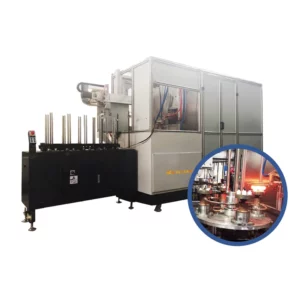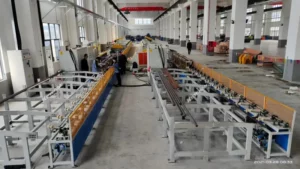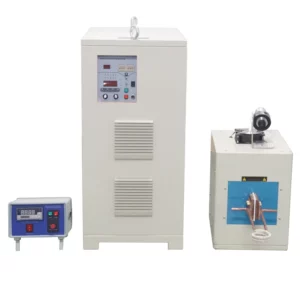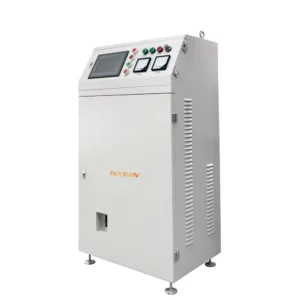What’s Induction tempering?
For the whole induction hardening workpiece, especially the induction through heating hardening workpiece, the application of induction heating tempering is more convenient to form the induction heat treatment assembly line, and more conducive to realizing mechanization and automation. Induction through heating quenching commonly used medium frequency generator (such as the heating of medium thickness steel plate, lead screw blank, bearing ring, etc.), induction tempering is a commonly used power frequency induction heating machine. A high-frequency induction heating machine can also be used for the thin parts local induction tempering process.
Induction tempering is using the electromagnetic induction method to make the heated workpiece internally generate an electric current. The energy of these eddies is used for induction heating and tempering, to reduce the tensile stress of the transition layer, the depth of heating should be larger than the depth of the hardened layer. Therefore, it is necessary to use a lower current frequency or smaller specific power to prolong the induction tempering time and make use of the workpiece heat conduction to thicken the heating layer. Because the induction heating tempering time is short, the induction tempering temperature should be appropriately increased. The workpiece after surface quenching by induction heating can be tempered in a furnace, self-tempering, or induction tempering.
Why use induction tempering?
Usually, after induction quenching, equipped with automatic temperature and time control of electric heating box furnace, well furnace, or mesh belt furnace. This kind of heat treatment process equipment with simple configuration, a simple process, reliable control, and mechanical parts stable tempering quality features. We call the induction tempering process of induction quenched parts the traditional tempering process.
The production of modern mechanical parts adopts the high speed assembly line heat treatment method. The traditional tempering process is not suitable for the working model of assembly line because of the long circulation cycle of parts in the tempering process equipment and the inconvenient clamping and positioning in the tempering process. The induction tempering production efficiency can be consistent with the induction quenching production efficiency, and the clamping position is consistent, so the induction tempering process and equipment are widely used in the modern induction heat treatment production line.
- Surface induction hardening: surface hardening enables the workpiece to have a hard shell and a tough core. Therefore, it can replace part of the carburizing, induction quenching, and tempering and nitriding processes, and save the alloying elements in the material. Due to the short heating time, the oxide scale is very small and the deformation is also small.
- Can do local induction hardening tempering: It can precisely heat the parts where the workpiece needs to be quenched, especially in the case of magnetic conductors and high power densities.
- Energy-saving induction heat treatment method: its energy consumption and carburizing, nitriding, quenching, and tempering compared with a great advantage when the quenching part of the workpiece quality and the overall quality of the greater the difference, its advantage is also more significant. Induction heat treatment often has high added value.
- Rapid induction heat treatment: the heating time of induction quenching is measured in seconds, and the production cycle is short. Especially in the case of self-tempering or random induction tempering, this process is similar to the machining process. For this purpose, modern induction tempering equipment has been arranged in the production line or automatic line.
- Clean induction heat treatment environment: the quenching liquid used for induction hardening is generally water or water solution with additives. When induction quenching and induction tempering process, there is almost no oil smoke and the working environment is good.
How to Find the Suitable Induction Tempering Process?
The traditional tempering process control and testing methods, that is, controlling temperature and testing surface hardness, cannot reflect and control the induction tempering quality of the quenching layer correctly and effectively. Induction tempering heating is characterized by induction eddy current heating, It has a surface skin effect and eddy intensity decreases exponentially with distance e, the effect of heat conduction is relatively weak. Improper induction tempering process will make the surface of the induction quenched hardened layer reach the tempering requirements of the process after induction tempering, but there is insufficient tempering in the internal of the induction quenched layer. Therefore, there must be power, heating time, surface temperature, surface hardness, hardening harden layer hardness gradient elements in the control and detection mode of induction tempering.
Induction tempering parameter selection: induction tempering frequency must be lower than the frequency of induction hardening because the tempering heating layer must be greater than the quenching heating layer; If the equipment conditions do not have quenching – tempering dual-frequency condition, the specific power of induction tempering should be 1/5 ~ 1/3 of induction quenching.
In total, for the complete induction tempering process, I want to say:
- The difference between the heating mode and heat conduction mode of induction tempering and traditional tempering makes the control and measurement of them have different requirements. Induction tempering requires power, heating time, surface temperature, surface hardness, and hardness gradient of hardened layer elements.
- The hardness gradient test of quenching layer after induction tempering reflects the adequacy of tempering hardness.
- According to the principle of induction heating, the induction tempering process ensures the tempering adequacy of parts.
So for more about the induction tempering process knowledge, welcome your letter for sharing more with you. Thanks.
Tags:Automatic Induction Heat Treating, Ball Stud hardening, Ball Stud heat treating, Ball Stud quenching, Ball Stud temepring, camshaft hardening, camshaft induction hardening, CNC hardening, CNC Quenching, CNC Quenching Machine, CNC Quenching Machine Tool, crankshaft hardening, crankshaft hardening machine, Disc CNC Hardening, for Sale, gear hardening, gear hardening heat treatment machine, gear induction hardening, Gear Induction Heating Machine, Gear Quenching Machine, Gear Teeth Quenching, heat treatment machine, High Frequency Induction Hardening, High Frequency Induction Quenching, Horizontal Hardening Machine Tool, induction ha, induction hardening, induction hardening auto valve, induction hardening machine, induction hardening tempering, induction heater, induction heating, induction heating machine, induction quenching, induction quenching machine, Induction Quenching System, Induction Scanner, Induction Scanning, induction shaft hardening, KETCHAN, KETCHAN Electronic, Manufacturers, price, rdening scanner, rod hardening, Shaft CNC Hardening Machine, shaft hardening, shaft heat treatment, shaft induction hardening, shaft induction hardening machine, shaft induction heating, shaft quenching machine, Suppliers, ultra high frequency quenching, vertical induction hardening machine, Zhengzhou KETCHAN, Zhengzhou KETCHAN Electronic
- You can visit Zhengzhou KETCHAN electronic Co.,ltd Youtube video room for more. Thanks.




